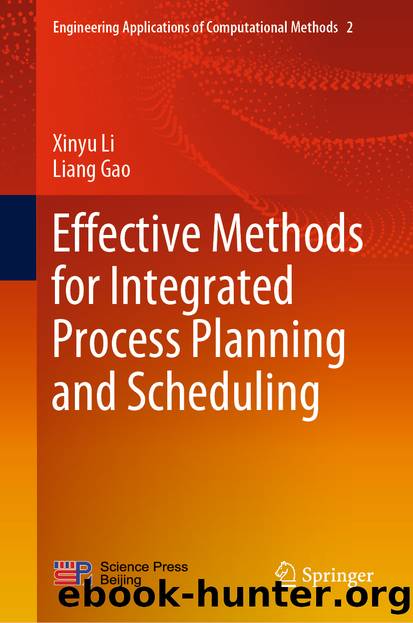Effective Methods for Integrated Process Planning and Scheduling by Xinyu Li & Liang Gao

Author:Xinyu Li & Liang Gao
Language: eng
Format: epub
ISBN: 9783662553053
Publisher: Springer Berlin Heidelberg
10.3.2.1 Job Agent
Job agents represent the jobs to be manufactured on the shop floor. Each agent contains the detailed information of a particular job, which includes the job ID, jobs’ types, quantities, due dates, quality requirements, CAD drawing, tolerance and surface finish requirements, etc. This agent also includes job status. In this study, the following statuses for the job agents are considered: (1) idle: the job agent is idle and waiting for the next manufacturing operations; and (2) manufacturing operation: the job agent is under manufacturing processes on machines. Based on the assumption in Sect. 10.3, when the job is under a manufacturing process on a machine, it cannot be processed by other machines. The function of this agent is to provide the jobs’ information to the MAS.
The job agents use the rules from the knowledge database and negotiate with the machine agents to generate all the alternative process plans of each job so they contain the information of alternative process plans.
There are three types of flexibility considered in process plans [23, 24]: operation flexibility, sequencing flexibility, and processing flexibility [23]. Operation flexibility [25], also called routing flexibility, relates to the possibility of performing one operation on alternative machines, with possibly distinct processing time and cost. Sequencing flexibility is decided by the possibility of interchanging the sequence of the required operations. Processing flexibility is determined by the possibility of processing the same manufacturing feature with alternative operations or sequences of operations. Better performance in some criteria (e.g., production time) can be obtained through the consideration of these flexibilities [25].
There are many methods used to describe the types of flexibility explained above [26], such as Petri net, and/or graphs and networks. In this research, a network representation proposed by Kim [25] and Sormaz [27] has been adopted here. There are three node types in the network: starting node, intermediate node and ending node [25]. The starting node and the ending node which are dummy ones indicate the start and end of the manufacturing process of a job. An intermediate node represents an operation, which contains the alternative machines that are used to perform the operation and the processing time required for an operation according to the machines. The arrows connecting the nodes represent the precedence between them. OR relationships are used to describe the processing flexibility in which the same manufacturing feature can be processed by different process procedures. If the links following a node are connected by an OR-connector, they only need to traverse one of the OR-links (the links connected by the OR-connector are called OR-links). OR-link path is an operation path that begins at an OR-link and ends as it merges with the other paths, and its end is denoted by a JOIN-connector. For the links that are not connected by OR-connectors, all of them must be visited [25].
Figure 10.2 shows two jobs alternative process plan networks (job 1 and 2) [18]. In the network of Fig. 10.2(2), paths {5, 6} and {7, 8} are two OR-link paths. For the links which are not connected by OR-connectors, such as {6, 7} and {8} in Fig.
Download
This site does not store any files on its server. We only index and link to content provided by other sites. Please contact the content providers to delete copyright contents if any and email us, we'll remove relevant links or contents immediately.
Bad Blood by John Carreyrou(6270)
Rich Dad Poor Dad by Robert T. Kiyosaki(6172)
Principles: Life and Work by Ray Dalio(5952)
Playing to Win_ How Strategy Really Works by A.G. Lafley & Roger L. Martin(5474)
Management Strategies for the Cloud Revolution: How Cloud Computing Is Transforming Business and Why You Can't Afford to Be Left Behind by Charles Babcock(4437)
The Confidence Code by Katty Kay(4033)
Thinking in Bets by Annie Duke(3995)
American Kingpin by Nick Bilton(3502)
Delivering Happiness by Tony Hsieh(3280)
Project Animal Farm: An Accidental Journey into the Secret World of Farming and the Truth About Our Food by Sonia Faruqi(3008)
The Power of Habit by Charles Duhigg(2960)
Mastering Bitcoin: Programming the Open Blockchain by Andreas M. Antonopoulos(2888)
Brotopia by Emily Chang(2888)
The Tyranny of Metrics by Jerry Z. Muller(2844)
I Live in the Future & Here's How It Works by Nick Bilton(2839)
The Marketing Plan Handbook: Develop Big-Picture Marketing Plans for Pennies on the Dollar by Robert W. Bly(2791)
The Content Trap by Bharat Anand(2775)
Building a StoryBrand by Donald Miller(2751)
Applied Empathy by Michael Ventura(2742)
